#theirmark
Text

Alexander or Wamsutta or else Sepaquitt. Their Mark.
Pokanoket, Wampanoag. His homelands across the southeastern coasts of the places commonly called Massachusetts and Rhode Island. Leader of the Wampanoag confederacy upon the death of his father, Ousamequin in 1661. Suspected by colonizers of Mass. Bay colony of colluding with the Narragansett against them; Wamsutta also angered European settlers in Massachusetts because of his land transactions with settlers in so-called Rhode Island. Wamsutta died suspiciously in 1662 after being detained and questioned by English settlers.
Their kin: A partner, Namumpum or Weetamoo. Their father Ousamequin, the Massasoit. Brothers Pometacom (or Philip) and Sonkanuhoo; sisters Amie and another whose name I am so far uncertain of.
This deed signed by Wamsutta on January 20, 1661, for lands bounded by the so-called “Seven Mile River ….southward till it come to the main sea, and then to run by the sea westward to Seconet.” John Sassamon is listed as “Interpreter Indian” at the signing of the deed.
#Seen at the Massachusetts State Archives.#wampanoag#pokanoket#wamsutta#alexander#sepaquitt#theirmark#theirmarks#easternwoodlands#nativehistory#sachem#17thcentury#firstindianwar#massstatearchives#massachusetts#rhodeisland#weetamoo#ousamequin#algonquian#namumpum#pometacom#johnsassamon
3 notes
·
View notes
Text
BTS and ARMY for BLM and More
I think many people are familiar with BTS and the dedication of their fans. What some people may not be aware of is the depth of BTS's philanthropic endeavors nor just how crucial ARMY's role is in BTS's transmedia and transcultural success. Combined, they have a rather incredible impact on the world that is unmatched by any other fandom. One of the most well known examples is when, during the peak of the BLM protests, BTS made a $1 million donation to BLM organizations and it was easily matched by BTS fans from around the world in just around 24 hours.
As one can imagine, there were certainly some people who tried to argue that BTS's donation was just a big publicity stunt. Of course, however, there were many more people who were ready to come to BTS's defense. As a group that heavily takes inspiration from Black American hip-hop and pop music, this donation is not just a lazy gesture but a conscious one that holds historical significance. It also shows that BTS is making genuine efforts to center Black voices and experiences in an attempt to to bridge the gap between races (Cho "BTS for BLM").
In general, one million dollars may also not be much for big name artists like BTS, but it is still not an insignificant number in terms of a donation. And you can't discredit the level of dedication and organization it took for their fans to match that number in a single day. The amount of effort that is put in behind the scenes by BTS fans is truly unlike any we see elsewhere and it has been stated that this highly organized structure of ARMY is "driven by a desire to see the seven members of BTS leave theirmark in territories previously uncharted by any other pop act from South Korea" (Moon).
BTS as a group and as individual members have been and have continued to donate millions of dollars to charities around the world including those that help children in Africa and children undergoing cancer treatments, on top of several various local South Korean charities.
Beyond these donations, BTS also launched their Love Myself campaign which aimed to end violence and promote the protection of young people. This was a global campaign that was in partnership with UNICEF and was trending with hundreds of thousands of BTS fans and others alike posting self-loving pictures with hashtags like #ENDviolence and $BTSLoveMyself. This campaign and partnership would ultimately bring them to the 73rd session of the United Nations General Assembly where the leader of BTS, RM, would give. a speech talking about his journey of learning to love himself and the purpose of the Love Myself campaign.
It's difficult to deny the positive impacts of BTS's philanthropic endeavors and the genuineness behind these actions is certainly one of the many reasons why fans love and care for the group as much as they do. These donations and campaign and BTS's consistent message of love and connection definitely speak for themselves, but I think the level of dedication and support that BTS receives from their fans across the world and their transmedial approach (use of several different platforms) is truly what sets them apart from other artists and what has led to their transnational and transcultural success.
Sources:
Acharya, Avani. “8 Times BTS Donated to Causes They Care About.” Www.sportskeeda.com, 17 Dec. 2022, www.sportskeeda.com/pop-culture/8-times-bts-donated-causes-care.
Cho, Michelle. “BTS for BLM: K-Pop, Race, and Transcultural Fandom.” Celebrity Studies, vol. 13, no. 2, Apr. 2022, pp. 1–10, https://doi.org/10.1080/19392397.2022.2063974.
Moon, Kat. “Inside the BTS ARMY, the Devoted Fandom with an Unrivaled Level of Organization.” Time Magazine, Nov. 2020.
0 notes
Text

The marke of Tasomockon (Tuspaquin)
Wampanoag. Their homelands at Nemasket and Assawompset (in the areas today called “Middleboro” and “Lakeville, Massachusetts”).Their mark appearing here on a document dated 1651, and signed also by Ousamequin, the Massasoit, and Ousamequin’s son, Wamsutta (later also called Alexander).
Tuspaquin’s kin: son of Pamontaquask. A partner, Amie (daughter of Ousamequin), their sons, Benjamin and Wiliam Tuspaquin.
This is our second post on Tuspaquin, whose mark is different across the two documents (dated 1651 and 1664) we’ve so far explored.
Seen at Massachusetts State Archives.
#tuspaquin#sachem#wampanoag#nemasket#assawompset#massachusetts#theirmarks#17thcentury#17c#massstatearchives#algonquian#easternwoodlands#nativehistory
17 notes
·
View notes
Text
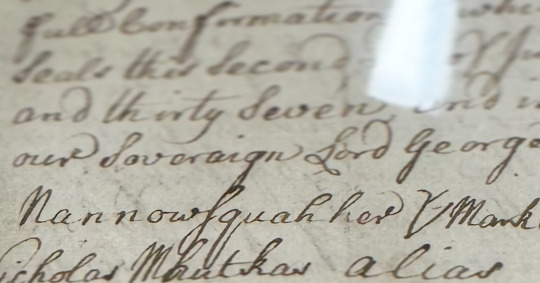
Nannowsquah. Her Mark & Seal
Mohican. Nannowsquah’s homelands in and around the areas known commonly today as “Berkshire County,” and parts of “Hampshire County, Massachusetts,” and beyond.
This document representing a conveyance of land along the Housatonic River in Mohican homelands. Nannowsquah (also spelled Naunowsquah) appears as one of several Mohican signatories.
The original document signed on June 2, 1737. This is a later copy.
Seen at Sawyer Library, Williams College.
#Nannowsquah#Naunowsquah#stockbridgemunseemohican#mohican#theirmarks#massachusetts#18thcentury#18c#williamscollege#algonquian#easternwoodlands#nativehistory
8 notes
·
View notes
Text

Cornelius Ind. his mark & seal
Mohawk. One of many signers of this document representing Mohawk homelands that spread across areas known today as eastern New York State, parts of western Vermont and parts of southern Ontario and Quebec
Cornelius is Identified within the text of this document as “Cornelius the Indian the youngest,” and appears alongside seven other Mohawk signers, who agreed to transfer land at the site of Fort Hunter west of so-called Albany, New York. Fort Hunter was constructed several years prior to the 1714 date of this deed, built by colonizers at the mouth of the Schoharie Creek, on the Mohawk River. Cornelius and others sign with pictographs and identify themselves as representatives of “we the three Races or Tribes of the Mohaugs Indians the Turtle, Wolf & B[ea]r.”
Signed in “Mohaughs Cuntry” May 14, 1716. Seen at Chapin Special Collections Library, Williams College.
#cornelius#mohawk#Haudenosaunee#theirmarks#easternwoodlands#nativehistory#18thcentury#18c#newyork#williamscollege#forthunter
4 notes
·
View notes
Text

James. His Mark.
Nipmuc, his homeplaces at Chaubunagungamaug and later perhaps at Quinnebaug (present day areas around and near Dudley and Webster, MA, and Thompson, CT, respectively). In this document, James is identified as the son and heir of “Black James Sachem of the Nipmug Country.”
Wullumahchein, or Black James, was a pawau or spiritual leader at Chaubunagungamag. Wullumachien was appointed “constable” to praying Indians by Daniel Gookin, signed a pledge not to fight against colonizers in King Philip’s war, and then fought against colonizers in King Philip’s war.
James’ kin: Father, Wullumahchein (aka Black James). Brother, Simon.
The original document was signed on December 27, 1686. The image here is from a later copy of the original, seen at the Massachusetts Historical Society.
#James#BlackJames#Wullumachien#nipmuc#chaubunagungamaug#websterma#dudleyma#thompsonct#connecticut#theirmarks#massachusetts#17thcentury#17c#masshistoricalsociety#algonquian#easternwoodlands#nativehistory
3 notes
·
View notes
Text

The mark of Nahnanacomock.
Penacook. Their homelands along the Merrimack river, and at the places where the present-day boundaries of so-called “New Hampshire,” “Maine,” and “Massachusetts” exist. This document, signed June 12, 1644, is interpreted as a peace agreement, signed by Passaconaway and Nahnanacomock on behalf of the Pennacook, and the Massachusetts Bay Colony.
Nahnanacomock’s kin: one source suggests Nahnanacomock is the son of Passaconaway.
Seen at the Massachusetts State Archives.
#nahnanacomock#pennacook#theirmarks#easternwoodlands#nativehistory#sachem#17thcentury#massachusetts#newhampshiire#maine#merrimackriver#massstatearchives#algonquian
3 notes
·
View notes
Text
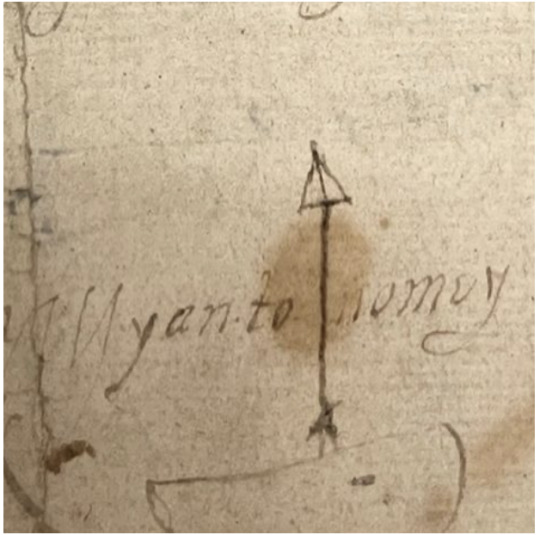
Miantonomo, Miantonomoh, Myantonomy. His Mark. (repost from 12.27.22)
Nahaganset (Narragansett). His home along the western shores of Narragansett Bay, in so-called Rhode Island, and into so-called eastern Connecticut. Sachem. In 1640s, appealed to sister tribes to create an alliance against colonizers. Brought to Mass. Bay Colony in 1640 on charges of conspiracy against settlers. Executed in Mohegan territory in 1643 following tensions with Mohegan sachem, Uncas and the English.
Place names mentioned in this deed, for so-called “Warwick, RI,” signed January 1642, include: “Sowhanes Bay,” “Copassanatuxett,” “Shawhomet” (spelled as they appear in the document).
His kin: Son of Mascus; nephew to Canonicus; brother to Pessicus; father of Canonchet. His partner: Wawaloam.
[Indian deed of Warwick, Rhode Island], 1642. Seen @ John Carter Brown Library, Providence, RI.
#nahaganset#narragansett#miantonomo#hismark#theirmarks#easternwoodlands#nativehistory#sachem#17thcentury#rhodeisland#johncarterbrownlibrary#connecticut#pessicus#cabibcget#wawaloam#mascus#algonquian#canonicus#shawomet
5 notes
·
View notes
Text

The Mark of Wutasakompanin.
Nipmuc. Also known as Captain Tom or Tom Wuttasacomponom. A Christian convert at Hassanamesit. Vowed loyalty to settlers during the First Indian War, or King Philip's War, but was still hung by colonizers in 1676 after accusations of being involved in the burnings of Sudbury and Medfield (which Wuttasacomponom denied).
This document, signed by Wuttasacomponom and others, reports to be submitted on behalf of “peoples of Nipmuck…the inhabitants of Quánutusset, Mônuhčhogok, Chaubunakongkomuk, Asukodnôcog, Kesépusqus, wabuhqushish and the adjacent parts of Nipmuk…” It pledges the submission of inhabitants of praying towns to the government of Massachusetts. It’s signed in 1668, a little less than a decade before the War would begin.
Below Wuttasacomponom’s mark is the signature of Job Kattenanit, brother of James Printer, whom we will write about at a later date.
Wuttasaompnoms kin: a son, Nehemiah Tom.
Seen at the Massachusetts State Archives.
#wutasakompanin#wuttasacomponom#nipmuc#hassanamesit#wabaquasset#theirmarks#easternwoodlands#nativehistory#17thcentury#17c#massachusetts#rhodeisland#masshistorical#algonquian
2 notes
·
View notes
Text
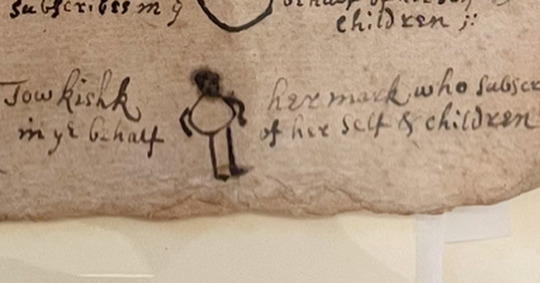
Towkishk. Her mark who subscribes in ye behalf of herself and children.
Wangunk. Their homelands across and around Pattaqounck or Pattaconk, in the southern part of present day central Connecticut. This document describes a part of land now called Haddam, Connecticut, “ …from mattabesett mill river to ye lower end of pattaquounck meadow on both sides of ye [Kwinitekw] river.”
In this deed, colonizers outline their desire for the land and “all ye trees stones mines minerals ponds brooks and rivers” in the area, in exchange for thirty coats.
Signed May 20, 1662. Seen at Mohegan Library and Archives.
#towkishk#wangunk#pattaconk#mattabesett#17thcentury#theirmarks#algonquian#easternwoodlands#nativehistory#17c#Connecticut#moheganlibraryandarchives
6 notes
·
View notes
Text
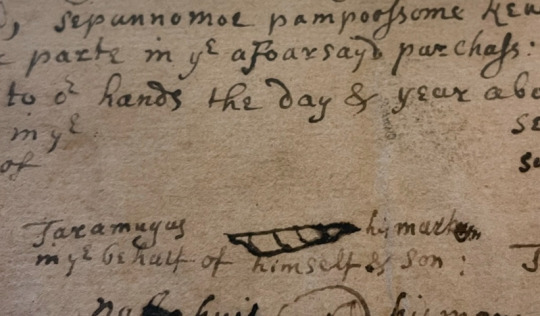
Tarramuggus. Turramuggas. Terramuggas. Taramugus his marke in ye behalf of himself & son.
Wangunk. Their homelands across and around Pattaqounck or Pattaconk, in the southern part of present day central Connecticut. This document describes a part of land now called Haddam, Connecticut, “ …from mattabesett mill river to ye lower end of pattaquounck meadow on both sides of ye [Kwinitekw] river.” The deed sets aside “Thirty mile Island & forty acres of land at pattaquounck which they [Wangunk] doe reserve…for them and their assignsf from ye day of ye date hereof forever without any interruption or molestation…”
Their kin: a father, Sowheage. A sister, Sepunnamo or Sepunnemoe. A partner, Keseso. A son, Peetoosoh.
Signed May 20, 1662. Seen at Mohegan Library and Archives.
#turramuggas#wangunk#pattaconk#connecticut#haddamconnecticut#mattabesett#theirmarks#17thcentury#17c#moheganlibraryandarchives#algonquian#easternwoodlands#nativehistory
2 notes
·
View notes
Text

Passaconaway. The Mark of Payassaconoway.
Penacook. Their homelands along the Merrimack river, and at the places where the present-day boundaries of so-called “New Hampshire,” “Maine,” and “Massachusetts” exist. Sachem. Pauwau. Diplomat. This document, signed June 12, 1644, is interpreted as a peace agreement, signed by Passaconaway and Nahnanacomock, on behalf of the Pennacook, and the Massachusetts Bay Colony.
Passaconaway’s kin: a son, Wannalancet.
Seen at the Massachusetts State Archives.
#passaconaway#penacook#wanalancet#theirmarks#easternwoodlands#nativehistory#sachem#17thcentury#massachusetts#newhampshiire#maine#merrimackriver#massstatearchives#algonquian
2 notes
·
View notes
Text
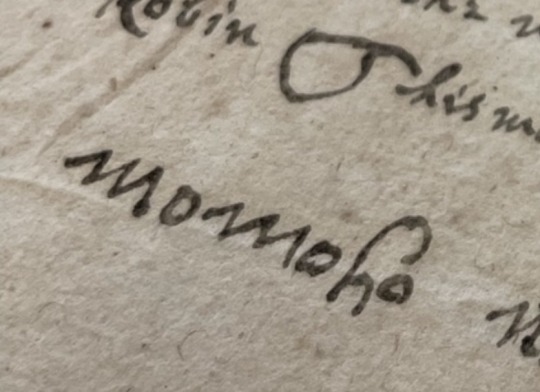
Momoho.
Eastern Pequot Sachem. Their home in and around the places today called “Mystic, Connecticut” and “Stonington, Connecticut.”
Momoho’s signed name appearing here on an October 1, 1676 appeal to the General Court of Connecticut, petitioning the court for access to hunting grounds, winter clothing, and wampum owed.
Seen at the John Hay Library, Providence, RI.
Some kin: Father, Tatobem. A daughter, Oskoosooduck (or Mary Momoho, Mary Ninigret or Mary Sowas). Sons, Wootagonkquam, Cutshamakin.
#pequot#easternpequot#momoho#theirmarks#easternwoodlands#nativehistory#sachem#17thcentury#connecticut#johnhaylibrary#algonquian
2 notes
·
View notes
Text

Canonicus. The mark of Caunonicus.
Sachem of the Nahaganset (Narragansett). His home along the shores of Narragansett Bay, in so-called Rhode Island, and into so-called eastern Connecticut. Born about 1565, died June 4, 1647. Initially a dubious opponent of colonizer settlement upon the arrival of the Pilgrims, Canonicus later signed a peace treaty with colonizers in 1644 - presumably in the pursuit of the survival of his nation.
This deed describes land on the island of “Acquidneck” and north to “Kitackamuckqutt,” but excludes “Chibachuwesa” or present-day Prudence Island.
The islands of Aquidneck, and the areas of Kickemuit and “the grass upon the rivers and coves about Kitackamuckqutt” and to Paupausquatch were exchanged for “40 fathom of white beads” plus ten coats and twenty hoes. Narragansett inhabitants of the island were then also told to “remove themselves” before the next winter.
Canonicus’ kin: a descendant of Tasshasuck. A brother, Mascus. Nephews Miantonomo and Pessicus. A son, Mixan (Mixan’s partner was Quaiapen).
Signed March 24, 1637. Seen at the Massachusetts State Archives.
#nahaganset#narragansett#canonicus#miantonomo#theirmarks#easternwoodlands#nativehistory#sachem#17thcentury#rhodeisland#masssstatearchives#aquidneck#pessicus#algonquian
2 notes
·
View notes
Text
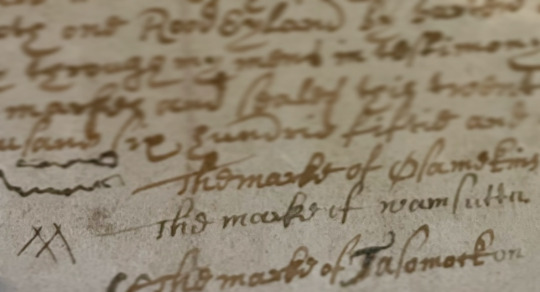
The Mark of Wamsutta.
Following up from last week’s post about Wamsutta: This mark is made on a document from 1651 (on which Ousamequin also appears, and which is also described in a previous post about Ousamequin’s mark). Signed in the time before Wamsutta petitioned settlers for an English name (Alexander). Here, Wamsutta uses a pictograph of a thunderbird as his mark.
Seen at Massachusetts Historical Society.
#wamsutta#ousamequin#pokanoket#wampanoag#massasoit#theirmarks#rhodeisland#massachusetts#easternwoodlands#nativehistory#sachem#17thcentury#masshistorical#algonquian
2 notes
·
View notes
Text


Osamekins Chefe Satchim. Ousamequin, Massasoit. Their Mark.
Pokanoket. His home at Sowams, on present-day Wampanoag homelands and in the southeastern parts of so-called “Rhode Island and Massachusetts.” As Great Sachem or Massasoit of the Wampanoag, Ousamequin led the people of the first light through the time of the great plague (1616-1619) and signed a treaty with European settler-colonizers in 1621, just after those settlers first arrived to the shores of Wampanoag territory. Ousamequiin continued to navigate a tenuous relationship with colonizers until his death in 1661. In this deed, signed in 1651, Ousamequin and other “nabor satchims” acknowledge the sovereignty and leadership power of their “beloved cosin” Nummampaum (Weetamoo) in her own territory at Pocasset.
Ousamequin’s kin: sons: Wamsutta, Pometacom and Sonkanuhoo. Daughters: Amie and another whose name I am so far uncertain of.
Deed signed July 26, 1651. Seen at the Massachusetts Historical Society.
Ousamequin means yellow feather in the Wampanoag dialect of the Algonquian language.
#ousamequin#pokanoket#wampanoag#sowams#massasoit#wamsutta#pometacom#theirmarks#rhodeisland#massachusetts#easternwoodlands#nativehistory#sachem#17thcentury#weetamoo#masshistorical#algonquian
2 notes
·
View notes